
Rediscovering Japan

Rediscovering Japan
Travel (Tokyo (Koishikawa Korakuen))

by tomizuta
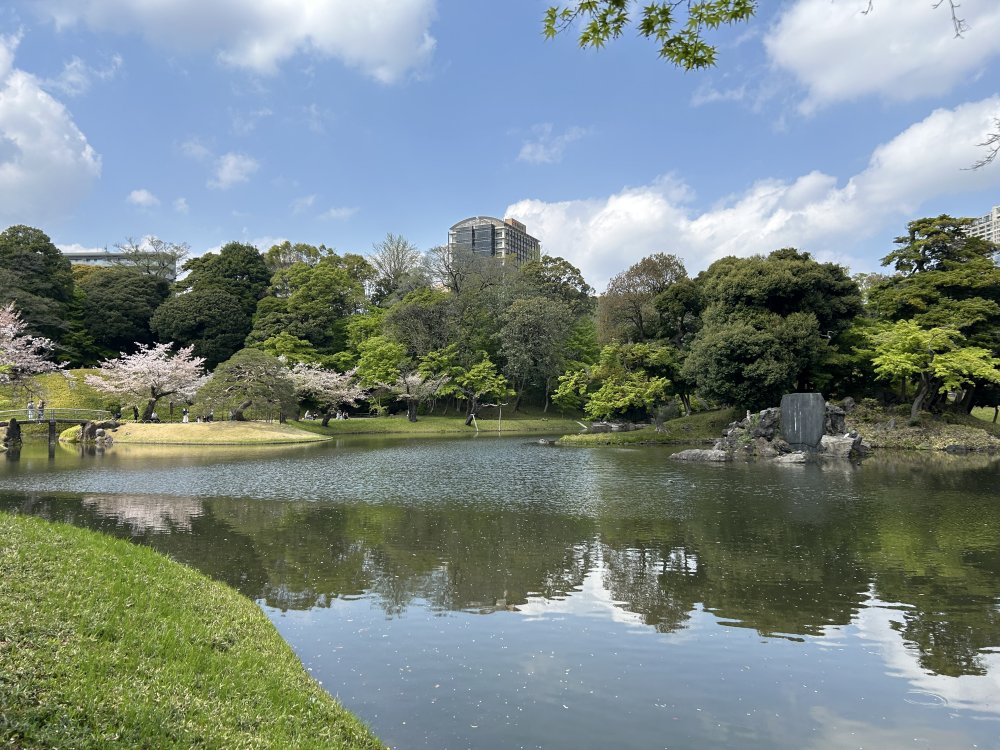
In March 1952, under the Act on the Protection of Cultural Properties, Koishikawa Korakuen was designated both a Special Historic Site and a Special Place of Scenic Beauty. Only nine sites throughout Japan, including the famous Golden Pavilion (Kinkaku-ji) and Silver Pavilion (Ginkaku-ji), hold both of these prestigious designations.
The place I most frequently guide international visitors is Asakusa. Before setting out, I show them a map of central Tokyo on my iPad to explain the layout of Edo—the former name of Tokyo until the Meiji Restoration. I point out how the Imperial Palace, formerly Edo Castle, lies at the center, surrounded by the inner and outer moats. I also explain that the estates of the feudal lords most closely allied with the Tokugawa shogunate were located from the west to the north of the outer moat. In contrast, merchant and commoner districts lay to the east of the castle, with the Sumida River marking the city's eastern edge. I then explain that our first stop, Asakusa, developed as a popular entertainment and leisure district for ordinary townspeople. Because it retains more of Edo’s traditional atmosphere than anywhere else in Tokyo, it makes an ideal starting point for visitors exploring Japan’s cultural heritage. After visiting Senso-ji Temple and Asakusa Shrine, if we decide to skip the Tokyo Skytree, we often take a water bus to Ryogoku. There, we visit the Yasuda Garden, which provides the perfect setting to introduce a typical Japanese promenade garden of a feudal lord. Many visitors go on from Tokyo to explore cities such as Kanazawa, Takayama, and Kyoto. One of my aim is to provide them with a basic understanding of Buddhism and Shinto, as well as the history and types of Japanese gardens, so they can better appreciate what they encounter later in their travels. I explain that although the techniques of garden-making were originally imported from Korea and China, Japan developed its own unique styles, such as Pure Land gardens, kare-sansui (dry landscape) gardens, and promenade gardens found in the former estates of feudal lords. Lately, after reading several books on the history of Japanese gardens, I’ve felt a strong desire to deepen my understanding by visiting actual gardens and observing their features firsthand. In April 2025, just after the cherry blossoms had passed their peak, I began this journey with a visit to Korakuen Garden in Koishikawa, near Suidobashi.
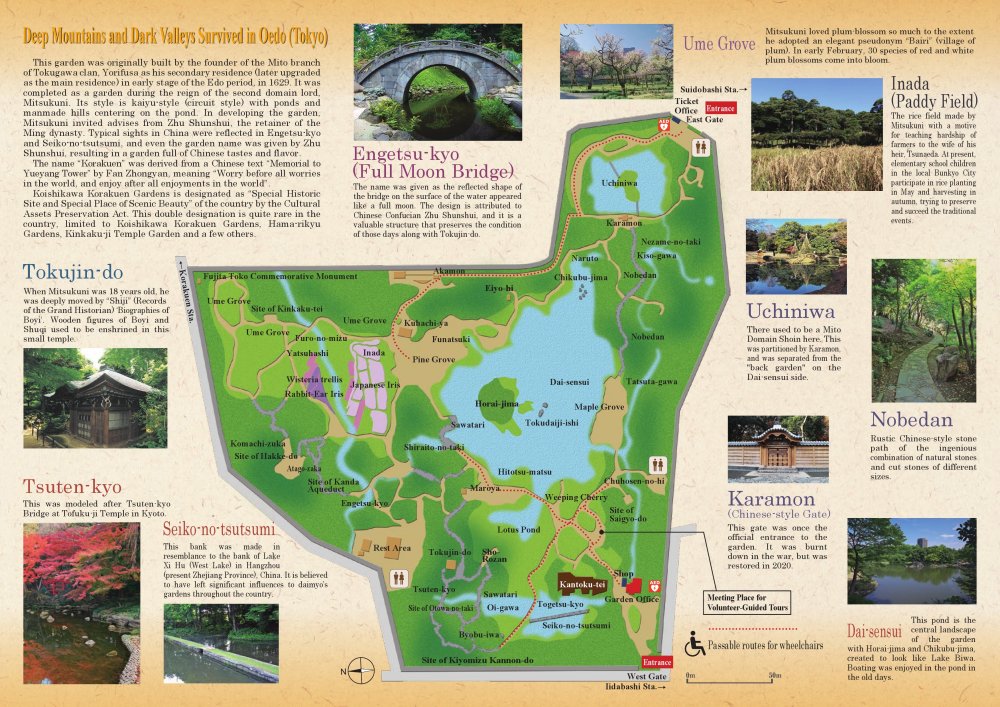
Map of Koishikawa Korakuen available on Tokyo Metropolitan Park Association's website. I entered the garden from the East Gate on the top right corner.
Korakuen Gardens in Koishikawa was created in the early Edo period as the
garden of the Mito branch of the Tokugawa family. Covering just over 70,000
square meters, it occupied the southwestern corner of their upper residence,
which spanned approximately 250,000 square meters and stood directly across
from the Koishikawa Gate of Edo Castle. After the Meiji Restoration, the
estates of the feudal domains were confiscated by the new government. Many
were either repurposed for governmental use or sold off to the private
sector. On the site of the former Mito estate, the Tokyo Artillery Arsenal
of the Imperial Army was established. While many daimyo gardens were lost
during this transitional period, Korakuen Gardens narrowly escaped that
fate. In 1936, the garden was transferred to the Tokyo City government,
and two years later, in 1938, it was opened to the public as a park—a status
it retains to this day. In March 1952, under the Act on the Protection
of Cultural Properties, it was designated both a Special Historic Site
and a Special Place of Scenic Beauty. Only nine sites throughout Japan,
including the famous Golden Pavilion (Kinkaku-ji) and Silver Pavilion (Ginkaku-ji),
hold both of these prestigious designations.
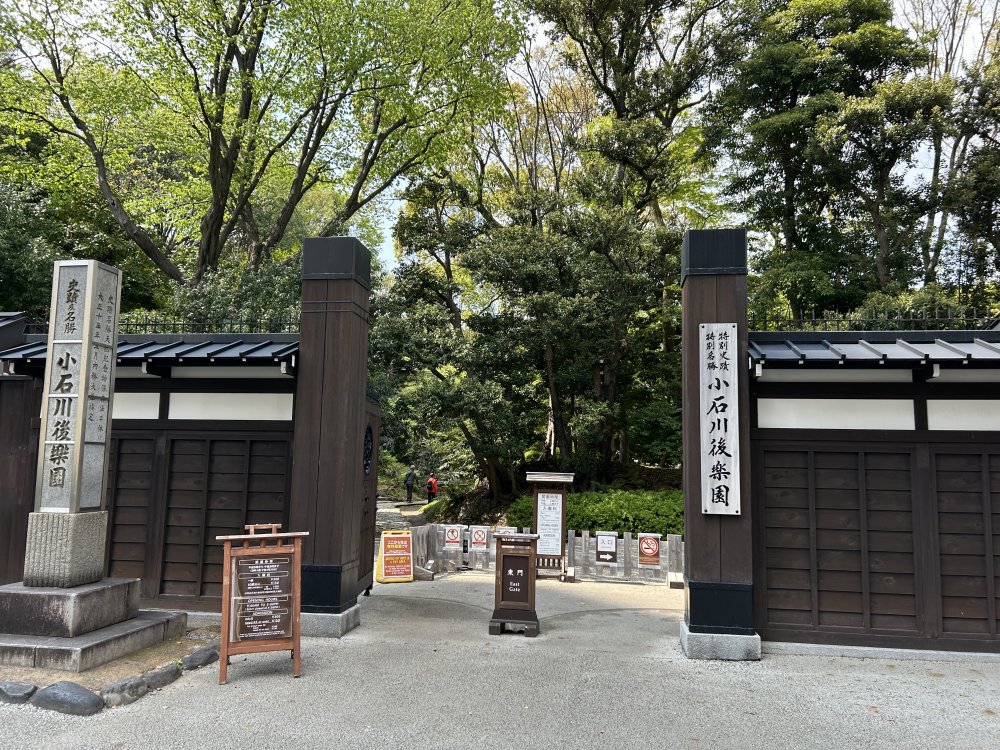
Coming from JR Suidobashi Station, it was about a 10 minutes' walk to the East Gate of Koishikawa Korakuen. The admission fee is 300 yen.
Starting from JR Suidōbashi Station, we walked westward, passed by the Tokyo Dome complex, and entered the garden through its east gate, located slightly north of the main road running along the JR Chuo Line. Upon entering, we immediately found ourselves in a compact Japanese garden.
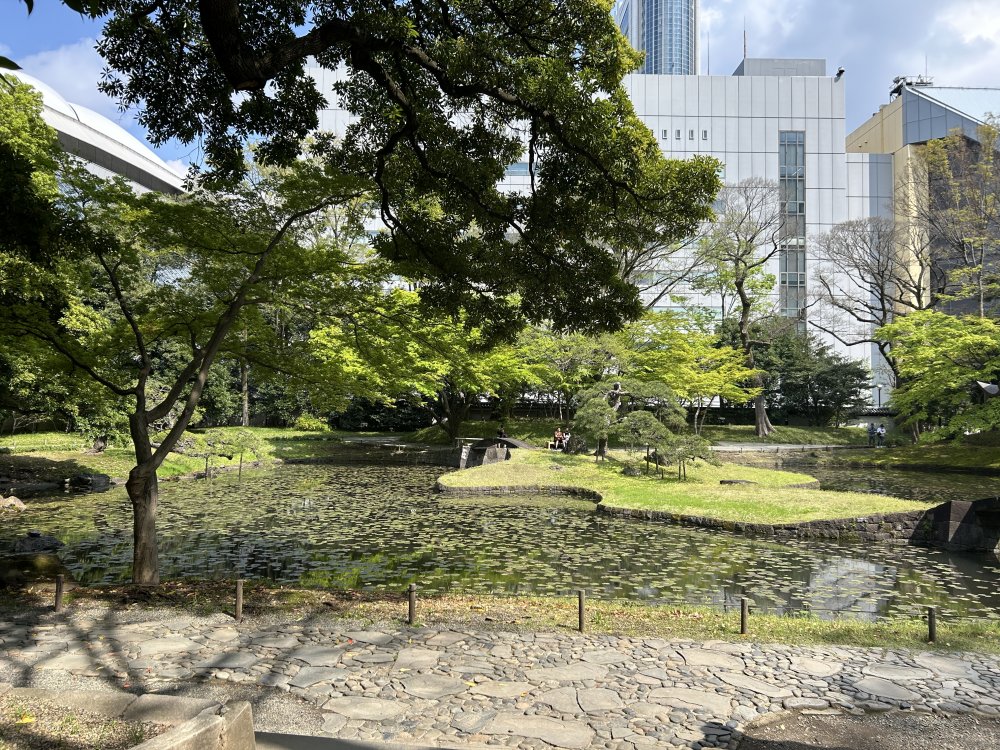
The Uchiniwa (inner garden), is a pretty private garden that once adjoined the shoin (main reception room for hosting guests) of the Mito Tokugawa residence.
This was the Uchiniwa (inner garden), a private garden that once adjoined the shoin (main reception room for hosting guests) of the Mito Tokugawa residence. Like many traditional Japanese gardens, it features a central pond, around which the garden is arranged. Following the path around the pond to the opposite side, we came upon a large Karamon gate. This Karamon gate marks the formal entrance to the main Korakuen Gardens. The name Karamon refers to an ornate gate design, characterized by its elegantly curved gables, a style that became prominent in castle and temple architecture from the Kamakura period onward. In historical times, only honored guests of the highest rank were permitted to pass through such a gate.
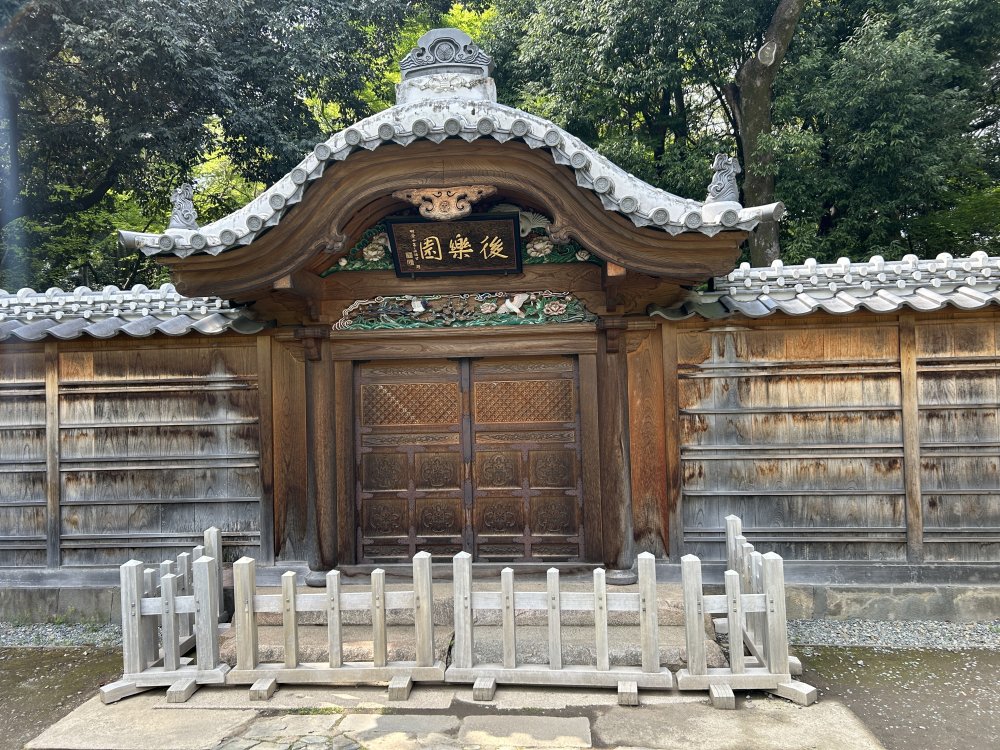
This Karamon was the formal entrance to the main Korakuen Gardens. The name Karamon refers to an ornate gate design, characterized by its elegantly curved gables, a style that became prominent in castle and temple architecture from the Kamakura period onward. The gate was reconstructed in 2020, 75 years after the original building was lost in the Tokyo bombing in 1945.
A characteristic feature of Japanese gardens is the use of mitate—a landscaping technique that symbolically represents natural elements or scenes, often by using materials like sand to suggest water or rocks to suggest waterfalls. From the 16th century onward, mitate also came to evoke famous scenic locations across Japan and sacred Buddhist sites, particularly in gardens built by feudal lords. In the case of Korakuen, the Daisensui pond is a symbolic representation of Lake Biwa. The layout envisions a journey beginning at the Karamon (representing Edo), passing through Lake Biwa, and continuing on to Kyoto before returning—along the way, various parts of the garden represent famous places throughout Japan. We walked around to the back of the Karamon gate (which remains closed except for special occasions) and entered a wooded path on the left. During the Edo period, there were two main routes connecting Edo and Kyoto: the Tokaido, which ran south along the Pacific coast, and the Nakasendo, which first headed north toward today’s Suwa in Nagano Prefecture, then turned south through Gifu and Shiga before reaching Kyoto. The mountainous portion of the Nakasendo between Suwa and Gifu was known as the Kisoji (Kiso Road). The wooded path we followed is a symbolic representation of the Kisoji, which winds southward along the Kiso River. Along the way, the garden also features references to landmarks found on this historic road, such as Nezame-no-toko, a famous scenic spot along the Kisoji.
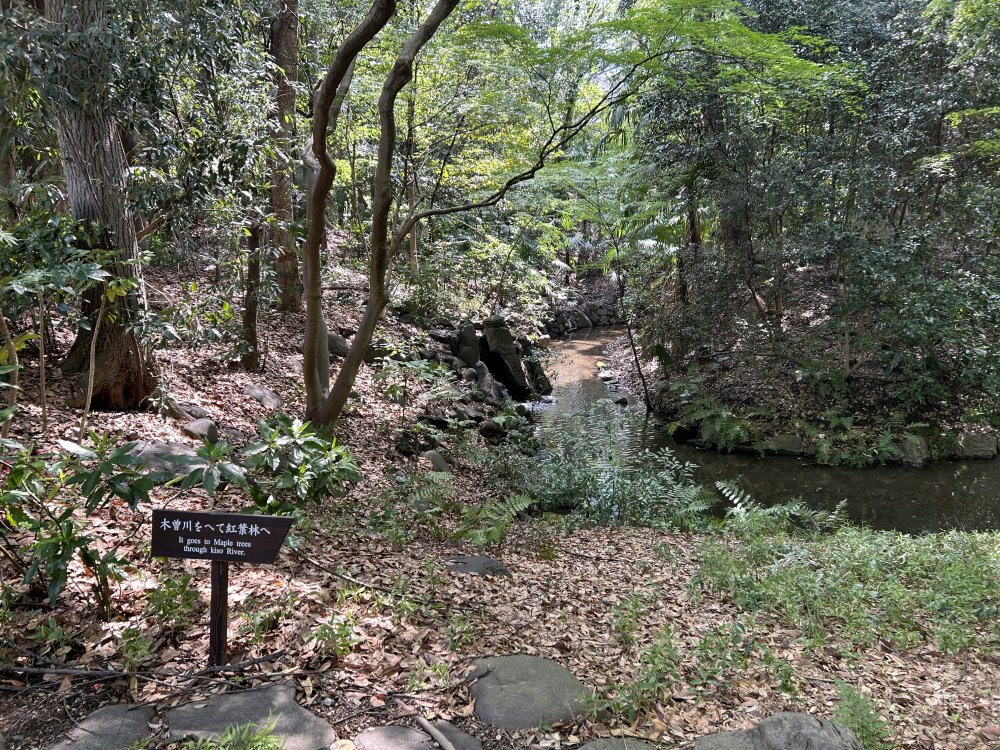
The wooded path we followed is a symbolic representation of the Kisoji, which winds southward along the Kiso River.
On weekends, Korakuen offers guided tours of the garden led by volunteer guides. While tours in English are less frequent than those in Japanese, they are available. After passing through the Kiso Road area, we headed toward the West Gate—where the guided tours assemble—walking alongside Daisensui. Each tour is limited to ten participants, so we hurried over, only to find that the number of people already gathered far exceeded that. Fortunately, there were two volunteer guides available, and the group was split so that everyone could take part. Our guide took a clockwise route. The first stop was Togetsukyo, a well-known landmark in Kyoto. Accepting that it is a "mitate (symbolic representation)", I felt it didn't particularly resemble the actual Togetsukyo which was originally a wooden bridge, not a stone bridge (although the current bridge reconstructed in 1934 is a stone bridge made to resemble a wood bridge).
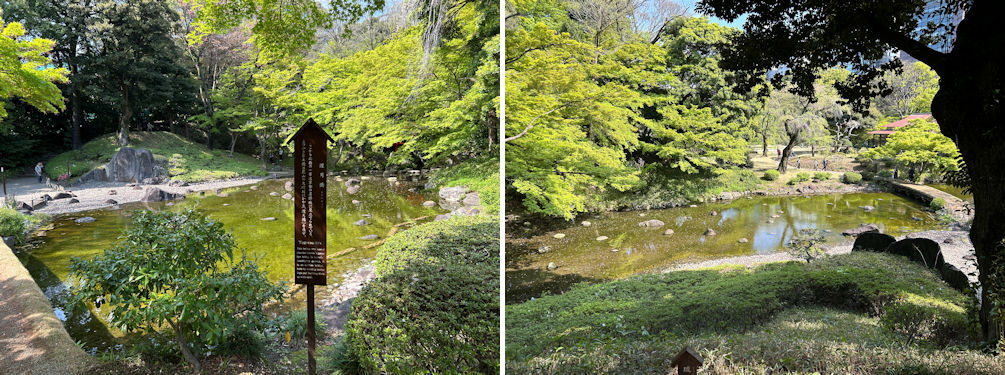
The mitate of Togetsukyo in Kyoto. Although charming, I felt it didn't particularly resemble the actual Togetsukyo (left). However, when I passed the bridge and viewed it from a short distance away on the other side (right), I thought perhaps it did convey something of the atmosphere of Togetsukyo.
Next, we visited the site of the Kannon-do. A word of caution is necessary here: this hillside route involves a number of slopes and uneven terrain, making it unsuitable for visitors with limited mobility. The Kannon-do was originally modeled after the famous Kiyomizu-dera Temple in Kyoto, but it was lost in the Great Kanto Earthquake of 1923 and only the foundation stones remain today.
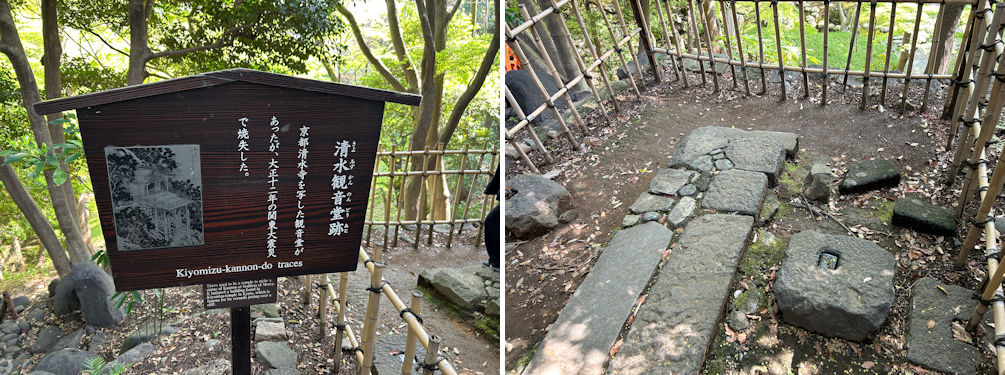
The description on the left tells the small Kannnon-do was lost in 1923 in the Great Kanto Earthquake, and that only the foundation stones remain to this day.
After climbing up and down the mountain path, we arrived at a small structure called Tokujin-do. The hall once enshrined statues of Boyi and Shuqi, revered Confucian sages featured in the Biographies of Boyi and Shuqi in the Records of the Grand Historian (Shiji)—figures said to have had a profound influence on Mitsukuni Tokugawa, the second lord of the Mito domain who completed the construction of Koishikawa Korakuen. Built between 1665 and 1668, Tokujin-do, along with the Engetsu-kyo (Full Moon Bridge), is one of the few remaining original structures in the garden dating back to the Edo period.
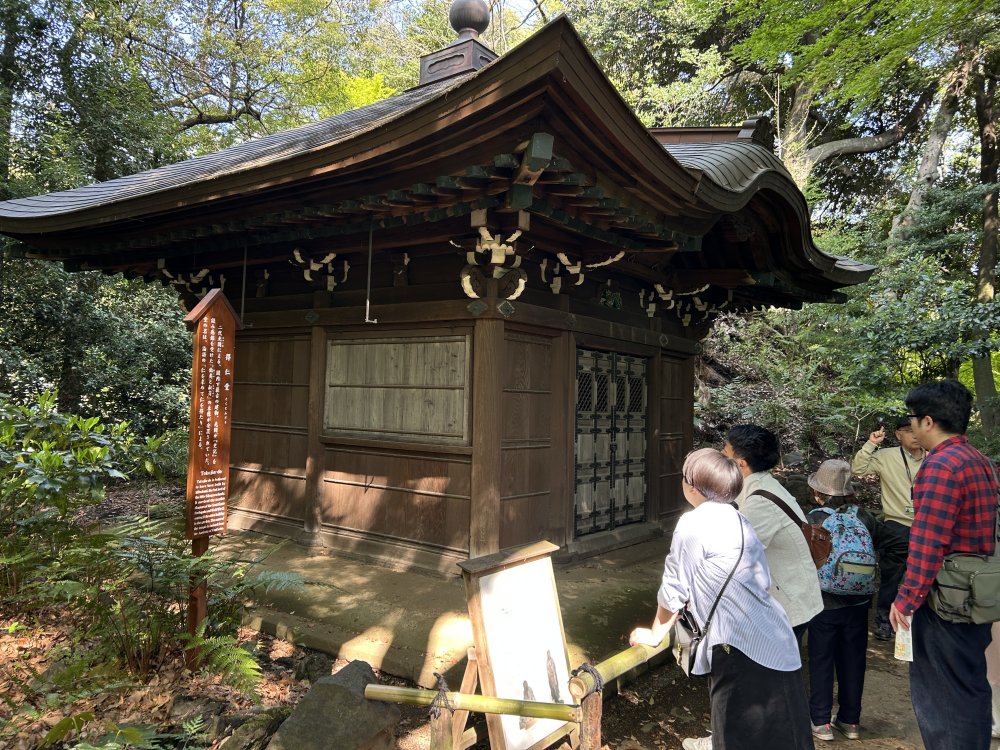
Tokujin-do, along with the Engetsu-kyo (Full Moon Bridge), is one of the few remaining original structures in the garden dating back to the Edo period.
Next, we visited the Engetsu-kyo (Full Moon Bridge). It is said to have been designed by Zhu Shunshui, a Confucian scholar from the Ming dynasty. The reflection of the bridge in the pond forms a perfect circle, resembling a full moon. It is also considered the oldest stone bridge in Japan. Incidentally, Koishikawa Korakuen originally made use of the Kanda Josui—a waterway that supplied clean water to the city of Edo—but since the discontinuation of this water supply, the garden now uses a pump system to draw up groundwater, which is purified and recirculated.
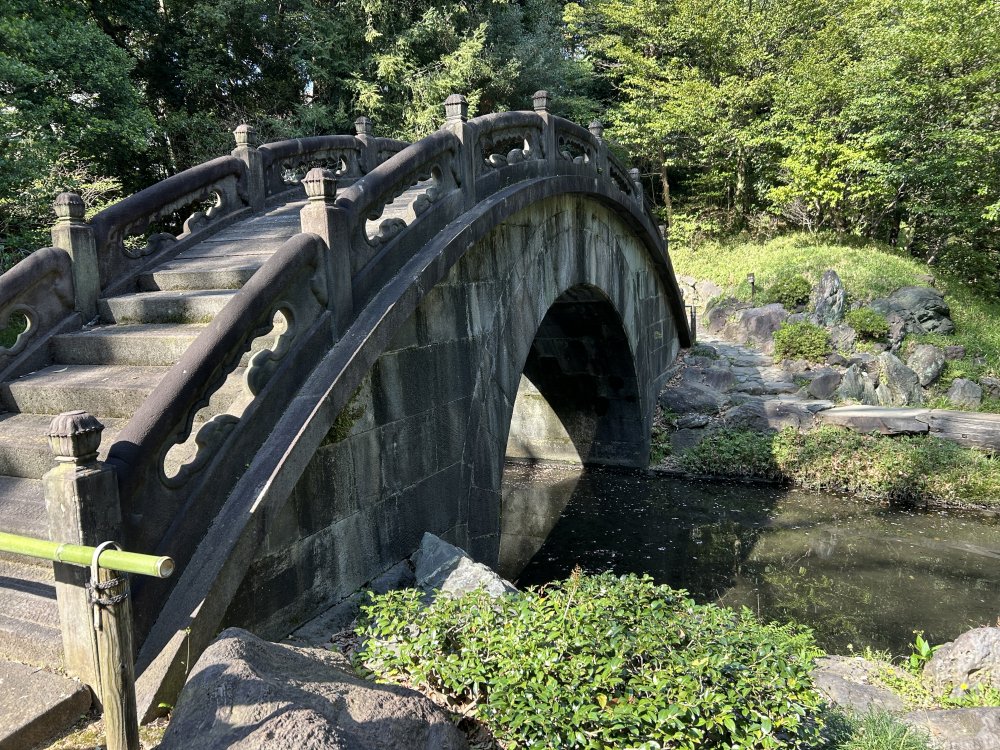
We next visited the Engetsu-kyo (Full Moon Bridge), said to have been designed by Zhu Shunshui, a Confucian scholar from the Ming dynasty. The reflection of the bridge in the pond forms a perfect circle, resembling a full moon.
Passing through the grove, we emerged into an open area. Here, there is a plum grove, iris beds (including native Japanese kakitsubata irises), a wisteria trellis—and even a rice paddy. Koishikawa Korakuen reflects the governing philosophy of Tokugawa Mitsukuni, who completed the garden. Using the explanation in the park’s official brochure, the name “Korakuen” was derived from a line in the Chinese text Memorial to Yueyang Tower by Fan Zhongyan: “Worry before all worries in the world, and enjoy after all enjoyments in the world.” The garden’s name Korakuen, written with the Kanji characters for “later,” “pleasure,” and “garden,” expresses a moral admonition—that those in positions of power should defer their own enjoyment until the people have had theirs. The rice paddy was also laid out according to this philosophy. It is said that Mitsukuni included it in the garden out of the belief that rulers should have firsthand knowledge of the hardships of farmers. We visited just after the cherry blossoms had ended, but this is a place one would want to return to and enjoy in every season.
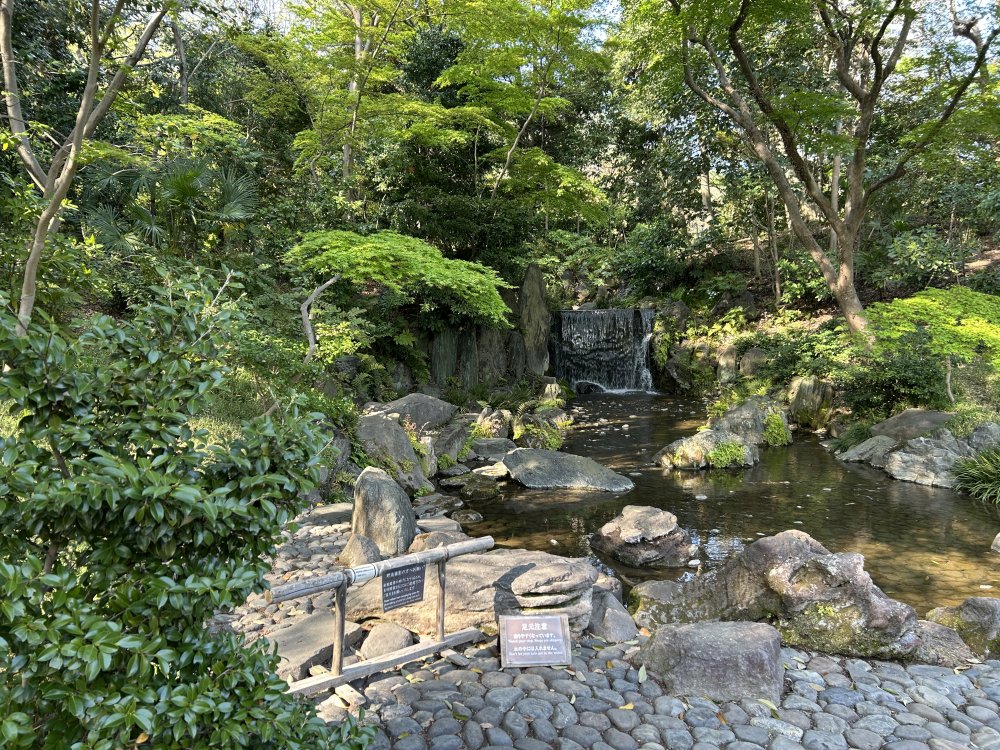
Another "mitate" of Shiraito Falls in the Mt. Fuji area. The iris beds and rice paddy are behind the falls.
Having now completed half a clockwise circuit around the Daisensui pond and reached the opposite bank near the West Gate where the tour had started, we were shown the remains of a boat landing. According to the guide, there are also landings on other parts of the pond, such as Horaisan Island in the center, suggesting that pleasure boating once took place here. After this, the tour returned to the front of the West Gate and disbanded. It had been about a one-hour tour. This visit strongly impressed upon me that I would very much like to include this course in future guided tours for foreign visitors.
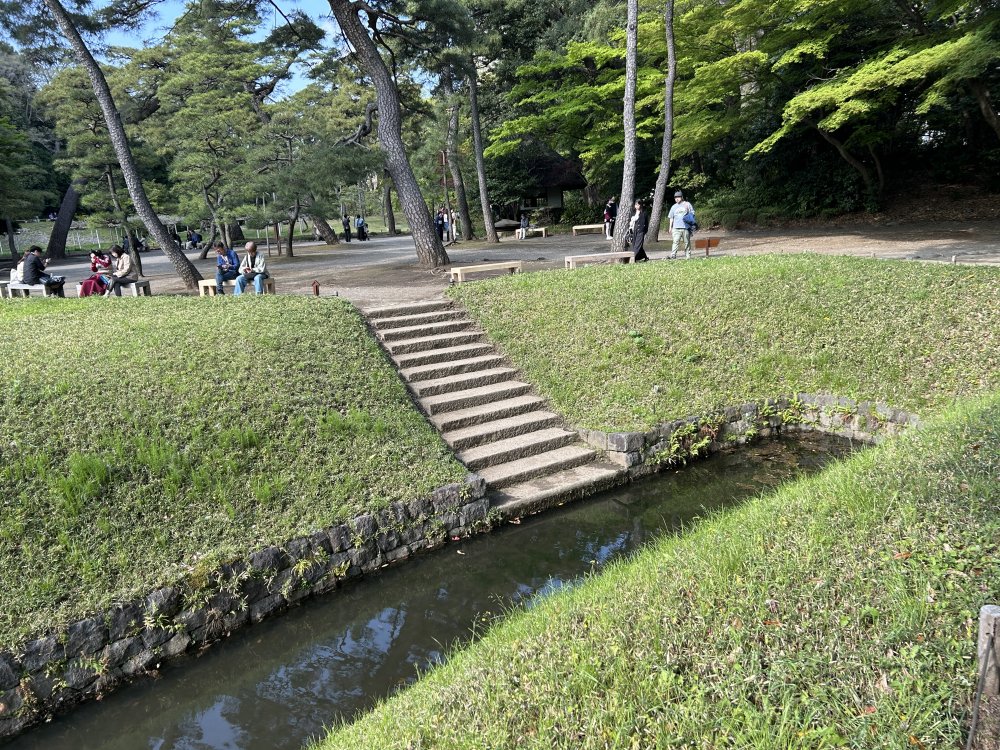
The remains of a boat landing. There are also landings on other parts of the pond, such as Horaisan Island in the center, suggesting that pleasure boating once took place here.